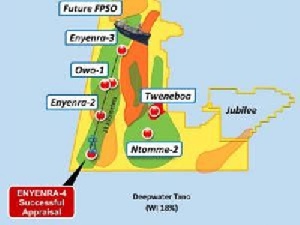 The TEN fields are located in the Deepwater Tano licence area and operated by Tullow Oil,
The TEN fields are located in the Deepwater Tano licence area and operated by Tullow Oil,
Increased oil production in Ghana is boosting energy sector revenues and helping shore up finances after three years of sluggish economic growth and persistent budget shortfalls.
A report from the central bank shows Ghana’s state oil revenues more than doubled between the second half of 2016 and the first half of this year, from $93.4m to $191.3m, driven largely by increases in production levels.
Output levels have risen steadily since the start of production at the Tweneboa, Enyenra and Ntomme (TEN) oilfields in August 2016, jumping from 91,000 barrels per day (bpd) that month to 121,000 in September 2016 and rising steadily thereafter, to 165,000 bpd as of March, according to the US Energy Information Administration. Together the three fields contributed $94.2m to the revenue figure, with the remaining $97.1m coming from the Jubilee oilfield, where production began in 2010 but has been slowly declining in recent years.
The TEN fields are located in the Deepwater Tano licence area and operated by Tullow Oil, which has a 47.2% stake alongside its joint venture partners Kosmos Energy (17%), Anadarko Petroleum Corporation (17%), GNPC (15%) and PetroSA (3.8%). Tullow expects production from the fields to average 23,600 barrels per day (bpd) this year.
The rises in output and revenue have benefitted state coffers, allowing the government’s Petroleum Holding Fund to distribute some $277.8m in that period – up from $141.9m in the previous six months – to government accounts including the Ghana Stabilisation Fund, which serves as a rainy day account, and the Ghana Heritage Fund, which serves as a savings pool for future generations.
Short-term production increases at TEN and Sankofa fields expected
Output should increase even further in the near future – in May the Sankofa field began producing oil ahead of schedule, and it is expected to start with natural gas as well in February 2018.
Sankofa is part of the $7.9bn Offshore Cape Three Points Project operated with a 47.2% stake by Eni, and partners Vitol (37.8%) and GNPC (15.0%). The new field is projected to generate some 45,000 bpd.
Together the TEN and Sankofa fields were initially expected to lift Ghana’s crude oil production to an average of 123,416 bpd this year, up from 88,487 bpd in 2016, according to projections in the March budget. However, as output has since risen from the newer fields, the deputy minister of energy, Mohammed Amin Adam, said in June total average production this year could top the 200,000-bpd mark.
The new fields’ added output should help Ghana move closer to its target of 6.3% economic growth for this year, up from 3.5% in 2016 and 3.9% in 2015. In an encouraging sign, the IMF recently raised its growth forecast for Ghana from 5.8% to 5.9% in 2017; however, it also warned in March that the country “remains at high risk of debt distress” and urged fiscal consolidation to bring down borrowing levels.
Ghana’s financial standing has taken a hit in recent years as prices for its main export products –gold, cocoa and especially oil – have fallen. This put downward pressure on the local currency: in the two years to August 2014 the cedi halved in value against the dollar, to GHS3.8:$1, and has since fallen further to GHS4.3:$1.
Sinking prices also affected business earnings and cut into receipts from corporate income taxes, driving a $278m shortfall in 2015 alone, according to the Natural Resource Governance Institute. The result has been a steady build-up of public arrears, with the debt-to-GDP ratio jumping from 34% in 2010 to 73% in 2016, according to the finance ministry.
Fall in revenues could impact ability to reduce fiscal deficit
Despite rising oil output and revenue, external factors still cloud the road ahead somewhat for the country’s finances.
Ghana based its 2017 budget on the assumption that Brent crude prices would average $56 per barrel, but these have since declined to $48.60 per barrel as of early September. This could limit Ghana’s ability to rein in its fiscal deficit to 6.5% of GDP this year, according to Courage Martey, an economist at Databank Group based in Accra.
The country is also facing broader challenges in meeting earnings targets: revenue and grants from January to April came in at GHS11bn ($2.5bn), 17% less than the budget had predicted, largely due to the decline in oil prices.
With such concerns in mind, in June the deputy finance minister, Charles Adu Boahen, announced that Ghana would ask the IMF to extend its $918m debt support programme, scheduled to end in April next year, to December 2018.
This Ghana economic update was produced by Oxford Business Group.